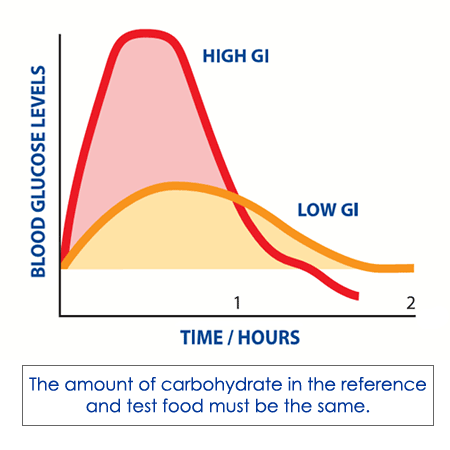Welcome to the home of the glycemic index – the official website for the glycemic index and international GI database based in the Boden Institute of Obesity, Nutrition, Exercise and Eating Disorders and Charles Perkins Centre at the University of Sydney.
The website is updated and maintained by the University’s GI Group which includes research scientists and dietitians working in the area of glycemic index, health and nutrition and headed by Professor Jennie Brand-Miller (AM, PhD, FAIFST, FNSA, MAICD) an internationally recognised authority on carbohydrates and the glycemic index with over 250 scientific publications. She is the co-author of many books for the consumer on the glycemic index and health and holds a Personal Chair in Human Nutrition in the Boden Institute of Obesity, Nutrition, Exercise and Eating Disorders and Charles Perkins Centre at the University of Sydney.

What is the Glycemic Index?
The glycemic index (or GI) is a ranking of carbohydrates on a scale from 1 to 100 according to the extent to which they raise blood sugar (glucose) levels after eating. Foods with a high GI (equal to or greater than 70) are those which are rapidly digested, absorbed and metabolised and result in marked fluctuations in blood sugar (glucose) levels. Low GI (equal to or less than 55) carbohydrates – the ones that produce smaller fluctuations in your blood glucose and insulin levels – is one of the secrets to long-term health, reducing your risk of type 2 diabetes and heart disease. It is also one of the keys to maintaining weight loss. Here is the evidence.
For diabetes: All of the evidence based recommendations for the management of diabetes from the major diabetes organisations around the world (the American Diabetes Association; Canadian Diabetes Association and Diabetes UK for example) now advise people with type 1 and type 2 diabetes to use the GI or GL as part of the nutritional management of their condition.
For gestational diabetes: In their recently released guidelines, Initiative on gestational diabetes mellitus: A pragmatic guide for diagnosis, management, and care, the International Federation of Gynecology and Obstetrics have recently recommended a focus on lower GI foods. “Low GI diets are associated with less frequent insulin use and lower birth weight than in control diets, suggesting that it is the most appropriate dietary intervention to be prescribed to patients with GDM,” they say.
For cholesterol: An analysis of 28 randomised controlled trials provided high-level evidence that high-fibre, low GI diets can significantly reduce total and LDL cholesterol levels, independent of weight loss.
For weight maintenance: The Diogenes study from Europe found that a moderately high protein, low GI diet is the best for longer-term weight management.
Measuring the GI
Following the international standard method, the GI value of a food is determined by feeding 10 or more healthy people a portion of the food containing 50 grams of digestible (available) carbohydrate and then measuring the effect on their blood glucose levels over the next two hours. For each person, the area under their two-hour blood glucose response (glucose AUC) for this food is then measured. On another occasion, the same 10 people consume an equal-carbohydrate portion of the sugar glucose (the reference food) and their two-hour blood glucose response is also measured. A GI value for the test food is then calculated for each person by dividing their glucose AUC for the test food by their glucose AUC for the reference food. The final GI value for the test food is the average GI value for the 10 people.
The GI of foods has important implications for the food industry. Terms such as complex carbohydrates and simple sugars are now recognised as having little nutritional or physiological significance. The WHO/FAO recommend that these terms be removed and replaced with the total carbohydrate content of the food and its GI value.

Glycemic Index Symbol Program: www.gisymbol.com
The GI Symbol Program was launched in Australia in 2002 to help consumers identify the GI of foods. Foods that carry the symbol are guaranteed to have been properly tested by an accredited laboratory using the international standard.


